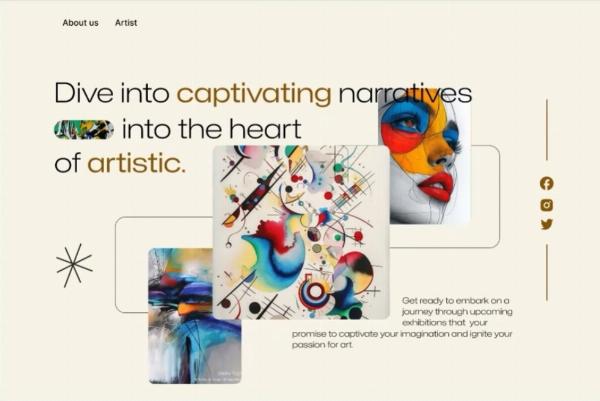SEO For Artists - 10 Game Changing Tips You Need To Know

Strong 8k brings an ultra-HD IPTV experience to your living room and your pocket.
In today’s digital age, having a strong online presence is crucial for artists looking to showcase their work, reach new audiences, and ultimately sell their pieces. With the rise of e-commerce and the growing influence of social media, understanding Search Engine Optimization (SEO) has become essential.
This comprehensive guide will provide artists with 10 game-changing SEO tips that will help them enhance their visibility online, attract more visitors to their websites, and effectively market their contemporary paintings and other artworks.
1. Optimize Your Website Structure
A well-structured website is the foundation of effective SEO. Ensure your website is easy to navigate, with a clear hierarchy of pages. Use descriptive and keyword-rich URLs, and organize your content into categories and subcategories that make sense for both users and search engines.
• Key Actions:
☉ Use breadcrumb navigation to help visitors and search engines understand the structure of your site.
☉ Create a sitemap and submit it to search engines.
☉ Optimize your website’s load speed by compressing images and using a reliable hosting provider.
2. Conduct Keyword Research
Keyword research is the process of identifying the words and phrases potential customers use when searching for art online. Use tools like Google Keyword Planner, Ahrefs or SEMrush to find relevant keywords for your artwork. Focus on a mix of broad keywords (e.g., "contemporary art") and long-tail keywords (e.g., "affordable contemporary paintings for sale").
• Key Actions:
☉ Identify high-volume, low-competition keywords.
☉ Use keywords naturally in your titles, headings and throughout your content.
☉ Avoid keyword stuffing, which can negatively impact your SEO.
3. Create High-Quality Content
Content is king in the world of SEO. Regularly updating your website with high-quality content can improve your search engine rankings and attract more visitors. Consider starting a blog where you can share insights about your creative process, stories behind your artworks and industry news.
• Key Actions:
☉ Write engaging and informative blog posts about contemporary art trends, techniques and exhibitions.
☉ Use a mix of text, images and videos to make your content more engaging.
☉ Update your blog regularly to keep your audience engaged and encourage repeat visits.
4. Optimize Images for SEO
As an artist, your website is likely filled with images of your artwork. Optimizing these images can significantly improve your SEO. Use descriptive file names, alt text, and captions to help search engines understand what your images depict.
• Key Actions:
☉ Use keywords in your image file names and alt text.
☉ Compress images to reduce load times without compromising quality.
☉ Create an image sitemap and submit it to search engines.
5. Leverage Social Media
Social media platforms like Instagram, Facebook and Pinterest are powerful tools for artists. Not only do they allow you to showcase your work to a broader audience, but they also contribute to your SEO efforts by driving traffic to your website.
• Key Actions:
☉ Share links to your blog posts and website on social media.
☉ Engage with your followers by responding to comments and messages.
☉ Use hashtags related to contemporary art to increase your visibility.
6. Build Backlinks
Backlinks, or links from other websites to yours, are a crucial factor in SEO. They signal to search engines that your site is trustworthy and authoritative. Reach out to art bloggers, online magazines and galleries to get them to link to your site.
• Key Actions:
☉ Write guest posts for art blogs and include links to your website.
☉ Collaborate with other artists and share each other’s content.
☉ Submit your website to online art directories and listings.
7. Use Local SEO
If you sell your artwork locally or have a physical gallery, local SEO is essential. Optimize your website to attract local customers by including location-specific keywords and creating a Google My Business profile.
• Key Actions:
☉ Include your city or region in your website’s meta tags and content.
☉ Encourage satisfied customers to leave reviews on your Google My Business profile.
☉ Add your business to local online directories.
8. Utilize Schema Markup
Schema markup is a form of microdata that helps search engines understand the content of your website better. By adding schema markup to your website, you can enhance your search engine listings with rich snippets, which can improve your click-through rates.
• Key Actions:
☉ Use schema markup to provide search engines with detailed information about your artwork, exhibitions, and events.
☉ Use Google’s Structured Data Markup Helper to create and implement schema markup on your site.
☉ Test your markup with Google’s Rich Results Test tool.
9. Optimize for Mobile
With more people using mobile devices to browse the internet, having a mobile-friendly website is crucial. Google uses mobile-first indexing, meaning it predominantly uses the mobile version of the content for indexing and ranking.
• Key Actions:
☉ Use a responsive design to ensure your website looks great on all devices.
☉ Test your website’s mobile usability with Google’s Mobile-Friendly Test tool.
☉ Ensure buttons and links are easily clickable on mobile devices.
10. Monitor and Analyze Your SEO Performance
Regularly monitoring your SEO performance allows you to see what’s working and what needs improvement. Use tools like Google Analytics and Google Search Console to track your website’s traffic, keyword rankings, and user behavior.
• Key Actions:
☉ Set up Google Analytics to monitor your website’s traffic and user behavior.
☉ Use Google Search Console to track your keyword rankings and identify any technical issues.
☉ Adjust your SEO strategy based on the data you collect.
Key Takeaways
◦ Website Structure: A clear and organized website structure improves navigation and SEO.
◦ Keyword Research: Identifying relevant keywords helps attract the right audience.
◦ Content Creation: High-quality content engages visitors and boosts SEO.
◦ Image Optimization: Properly optimized images enhance your site's SEO.
◦ Social Media: Leveraging social media drives traffic to your website.
◦ Backlinks: Building backlinks increases your site's authority.
◦ Local SEO: Optimizing for local search helps attract local customers.
◦ Schema Markup: Using schema markup improves your search engine listings.
◦ Mobile Optimization: A mobile-friendly site is crucial for modern SEO.
◦ Performance Monitoring: Regular analysis helps refine your SEO strategy.
FAQs
‣ What is SEO, and why is it important for artists?
◦ SEO, or Search Engine Optimization, is the process of optimizing your website to rank higher in search engine results. For artists, SEO is crucial as it increases the visibility of your artwork, attracting more potential buyers and followers.
‣ How do I find the right keywords for my art website?
◦ Use tools like Google Keyword Planner, Ahrefs, or SEMrush to identify keywords that are relevant to your artwork. Focus on a mix of broad and long-tail keywords to attract a diverse audience.
‣ Can social media really impact my SEO?
◦ Yes, social media can drive traffic to your website, which can positively impact your SEO. Engaging with your audience on social media also increases your online presence and visibility.
‣ How often should I update my blog?
◦ Aim to update your blog regularly, at least once a month, to keep your audience engaged and improve your SEO. Consistency is key.
‣ What is schema markup, and how does it benefit my art website?
◦ Schema markup is a form of microdata that helps search engines understand your website's content. It can enhance your search engine listings with rich snippets, improving your click-through rates.
‣ Is it necessary to have a mobile-friendly website?
◦ Yes, with the majority of internet users browsing on mobile devices, having a mobile-friendly website is essential. Google also uses mobile-first indexing, making it crucial for SEO.
‣ How can I build backlinks to my art website?
◦ Reach out to art bloggers, online magazines, and galleries to get them to link to your site. You can also write guest posts, collaborate with other artists, and submit your website to online directories.
‣ What tools can I use to monitor my SEO performance?
◦ Google Analytics and Google Search Console are essential tools for monitoring your website's traffic, keyword rankings, and user behavior. These tools provide valuable insights to refine your SEO strategy.
‣ How does local SEO benefit artists?
◦ Local SEO helps artists attract customers in their local area. By optimizing your website for local search, you can reach people who are more likely to visit your gallery or purchase your artwork.
‣ What are some common mistakes to avoid in SEO for artists?
◦ Avoid keyword stuffing, neglecting mobile optimization, and failing to update your content regularly. Focus on creating high-quality content and building a user-friendly website.
Conclusion
By implementing these 10 game-changing SEO tips, artists can significantly improve their online presence, attract more visitors, and ultimately increase their sales. Whether you're showcasing contemporary art or any other form of artwork, a strong SEO strategy is essential for success in today's digital world. Remember, SEO is an ongoing process, so continue to monitor and adjust your strategy to stay ahead of the competition.
Note: IndiBlogHub features both user-submitted and editorial content. We do not verify third-party contributions. Read our Disclaimer and Privacy Policyfor details.


